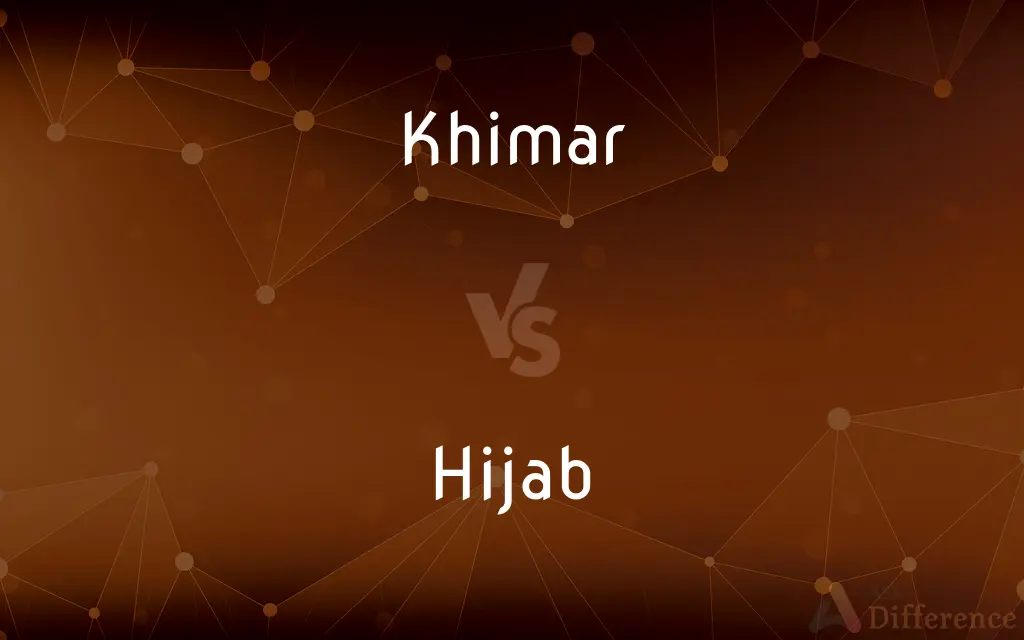Khimar vs. Hijab — What's the Difference?
Edited by Tayyaba Rehman — By Fiza Rafique — Updated on October 5, 2023
Khimar is a specific type of head covering that drapes over the chest, traditionally worn by Muslim women. Hijab refers broadly to modest dressing in Islam, often signifying a headscarf covering the hair.

Difference Between Khimar and Hijab
Table of Contents
ADVERTISEMENT
Key Differences
Khimar and hijab are both terms associated with Muslim women's attire that signify modesty, but they have distinct meanings and applications. Khimar refers to a particular kind of head covering that not only covers the hair but also drapes over the shoulders and chest, ensuring a significant portion of the upper body is covered. Hijab, on the other hand, has a broader meaning in the context of Islamic modesty and decency. While often used in popular discourse to refer to the headscarf worn by Muslim women, hijab encompasses more than just the headscarf.
The term hijab derives from the Arabic root meaning "to hide from view" or "to conceal." In an Islamic context, it refers to the principle of modesty and includes behavior as well as dress for both males and females. For many, hijab signifies a personal commitment to a pious life. Khimar, meanwhile, is more specific in its reference to a piece of clothing.
In daily usage, especially in the Western context, when people refer to the "hijab," they are often referring to the headscarf that covers the hair, neck, but leaves the face exposed. This can lead to some confusion, as the "hijab" in a stricter sense could be any form of dress that adheres to the Islamic code of modesty, which might include the khimar, but also other garments like the abaya or jilbab.
Around the world, Muslim women have various styles and preferences when it comes to adhering to the concept of hijab. While some may opt for the khimar due to its comprehensive coverage, others might choose different styles of headscarves or even decide not to wear one at all. The choice often reflects personal beliefs, cultural influences, and individual interpretations of religious texts.
In summary, while both khimar and hijab relate to Islamic principles of modesty, the former is a specific garment, and the latter is a broader concept that encompasses modest behavior and dress, which includes, but is not limited to, the headscarf commonly recognized as the "hijab."
ADVERTISEMENT
Comparison Chart
Definition
A specific type of head covering draping over chest and back.
Broadly refers to modest dressing in Islam.
Scope
Refers specifically to a garment.
Can refer to a concept or a specific garment.
Coverage
Covers hair, neck, chest, and back.
Typically covers hair and neck.
Origin
Arabic term for a draped covering.
Arabic term meaning "to hide or conceal."
Cultural Variations
Style remains relatively consistent.
Styles vary significantly across cultures.
Compare with Definitions
Khimar
A head covering worn by Muslim women that drapes over the chest.
She chose a blue khimar to match her outfit.
Hijab
A symbol of modesty and privacy often seen in Islamic cultures.
The hijab is an integral part of her identity.
Khimar
A specific attire worn for religious or cultural reasons by some Muslim women.
She wore her khimar whenever she visited the mosque.
Hijab
A headscarf worn by many Muslim women covering the hair.
She wore a hijab as a sign of her faith.
Khimar
A traditional Islamic garment covering the head and upper body.
The khimar is often worn with an abaya or jilbab.
Hijab
A piece of cloth that represents respect, dignity, and reverence.
Her hijab reflected her commitment to her beliefs.
Khimar
A draped garment that extends beyond the head to cover the upper body.
Her khimar flowed elegantly, complementing her posture.
Hijab
The practice of modesty in dress and behavior in Islam.
For her, wearing the hijab was a deeply personal choice.
Khimar
A piece of cloth used to ensure modesty by covering the hair and shoulders.
The market had khimars in various colors and designs.
Hijab
A veil that covers the head and chest, adhering to Islamic codes.
There's a misconception that the hijab restricts freedom, but many wear it by choice.
Khimar
A long headscarf worn by Muslim women, typically gathered or fastened under the chin and covering the body to a variable length.
Hijab
A hijab (; Arabic: حجاب, romanized: ḥijāb, pronounced [ħɪˈdʒaːb] in common English usage) is a religious veil worn by Muslim women in the presence of any male outside of their immediate family, which usually covers the hair, head and chest. The term can refer to any hair, head, face, or body covering worn by Muslim women that conforms to Islamic standards of modesty.
Khimar
A long veil worn by Muslim women as part of hijab.
Hijab
Any of several cloth head coverings worn by Muslim women.
Khimar
A headscarf worn by observant Muslim women that hangs down to just above the waist
Hijab
The veiling of women in some Islamic societies, customarily practiced in order to maintain standards of modesty.
Hijab
The practice, among Muslim women, of covering the body after the age of puberty in front of non-related adult males.
Hijab
(countable) A traditional headscarf worn by Muslim women, covering the hair and neck.
Hijab
A headscarf worn by Muslim women; conceals the hair and neck and usually has a face veil that covers the face
Hijab
The custom in some Islamic societies of women dressing modestly outside the home;
She observes the hijab and does not wear tight clothing
Common Curiosities
What's the difference between a hijab and a niqab?
A hijab usually covers the hair and neck, while a niqab covers everything but the eyes.
Can the term hijab refer to modest dressing for men?
Yes, in broader terms, hijab refers to modesty and can apply to both males and females.
Does the khimar cover the face?
Typically, the khimar covers the hair, neck, and chest but leaves the face exposed.
Is hijab only a religious symbol?
While rooted in religion, for many, the hijab also holds cultural, personal, and political significance.
Can wearing hijab be a feminist act?
Many women view choosing the hijab as an empowering and feminist decision, counter to some Western perceptions.
Is hijab mandatory in Islam?
Interpretations vary, but many believe the hijab is a religious obligation for Muslim women.
Do all countries mandate the wearing of a khimar?
No, wearing a khimar is mandated in a few countries, but in many places, it's a personal choice.
Is the khimar worn by all Muslim women?
No, wearing the khimar is a personal choice, and practices vary among individuals and cultures.
Are there different styles of khimar?
Yes, while the basic design is consistent, variations exist in length, design, and material.
Is the khimar only black?
No, khimars come in various colors and patterns, though black is common in certain regions.
What's the significance of the hijab in Islam?
The hijab is seen as an act of modesty, reverence to God, and a reflection of one's faith.
Why do some women choose not to wear the hijab?
Reasons vary, including personal beliefs, cultural influences, or individual interpretations of religious texts.
Is the khimar similar to a shawl?
While both are draped garments, a khimar has a specific design to cover the hair, neck, and often the upper body.
Is it disrespectful for non-Muslims to wear a hijab?
Context matters. Wearing it respectfully in appropriate settings (like visiting a mosque) is often appreciated, but using it as a fashion statement can be seen as appropriation.
Does wearing a khimar or hijab get hot?
Like any clothing, comfort can vary based on material and weather. Many garments are designed to be breathable.
Share Your Discovery

Previous Comparison
Podiatrist vs. Pediatrician
Next Comparison
Elasticated vs. ElasticAuthor Spotlight
Written by
Fiza RafiqueFiza Rafique is a skilled content writer at AskDifference.com, where she meticulously refines and enhances written pieces. Drawing from her vast editorial expertise, Fiza ensures clarity, accuracy, and precision in every article. Passionate about language, she continually seeks to elevate the quality of content for readers worldwide.
Edited by
Tayyaba RehmanTayyaba Rehman is a distinguished writer, currently serving as a primary contributor to askdifference.com. As a researcher in semantics and etymology, Tayyaba's passion for the complexity of languages and their distinctions has found a perfect home on the platform. Tayyaba delves into the intricacies of language, distinguishing between commonly confused words and phrases, thereby providing clarity for readers worldwide.














































